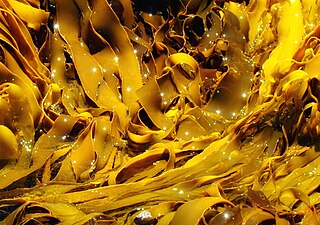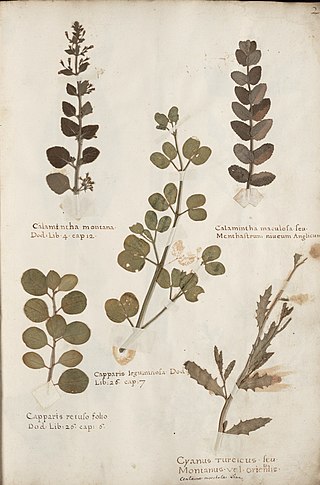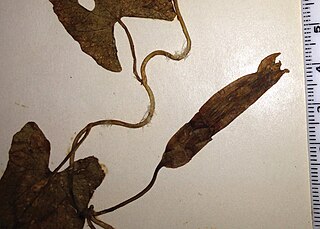

Seaweed collecting is the process of collecting, drying, and pressing seaweed. It became popular as a pastime in the Victorian era and remains a hobby today. [2]


Seaweed collecting is the process of collecting, drying, and pressing seaweed. It became popular as a pastime in the Victorian era and remains a hobby today. [2]
Collecting seaweed can be traced back to at least the 17th century with the pressings found in Hans Sloane's Herbarium. [3]
The pastime became increasingly popular during the Victorian Era, where it played to the burgeoning interest in natural history and collection in general. It was especially fashionable with young women, as it allowed a greater level of personal freedom. [4] Indeed, it was so in-style that, as a young girl, Queen Victoria created her own seaweed album. The materials needed for the hobby became readily available at seaside shops. [5] These activities also afforded women the opportunity to display their understanding and appreciation of the natural world. [6]

Anna Atkins, thought to be the first female photographer, published the first book using photographs as illustrations. This was Photographs of British Algae: Cyanotype Impressions and contained pictures of seaweed. [7]
The actions of some of the collectors earned them recognition and admiration from their male, professional counterparts. [8]
These Victorian collections form valuable historical resources [9] for morphological studies and from which genomic DNA can be extracted. [10]
In his 1881 book, A.B. Hervey recommended the following equipment for collecting and pressing seaweed.
You should have a pair of pliers; a pair of scissors; a stick like a common cedar "pen stalk," with a needle driven into the end of it, or, in lack of that, any stick sharpened carefully; two or three large white dishes, like "wash bowls" botanist's "drying paper;" or common blotting paper; pieces of cotton cloth, old cotton is the best; and the necessary cards or paper for mounting the plants on. [11]

Phycology is the scientific study of algae. Also known as algology, phycology is a branch of life science.

A herbarium is a collection of preserved plant specimens and associated data used for scientific study.

Plant collecting is the acquisition of plant specimens for the purposes of research, cultivation, or as a hobby. Plant specimens may be kept alive, but are more commonly dried and pressed to preserve the quality of the specimen. Plant collecting is an ancient practice with records of a Chinese botanist collecting roses over 5000 years ago.

William Henry Harvey, FRS FLS was an Irish botanist and phycologist who specialised in algae.
Elsie May Burrows was an English botanist who made significant contributions to British postwar phycology. Her primary area of research was macroalgal ecology, focusing particularly on Fucus, a genus of brown algae, and Chlorophyta, a division of the green algae.

Phycologia Australica, written by William Henry Harvey, is one of the most important 19th-century works on phycology, the study of algae.
The history of phycology is the history of the scientific study of algae. Human interest in plants as food goes back into the origins of the species, and knowledge of algae can be traced back more than two thousand years. However, only in the last three hundred years has that knowledge evolved into a rapidly developing science.
Gelidium is a genus of thalloid red algae comprising 134 species. Its members are known by a number of common names.

Seaweed, or macroalgae, refers to thousands of species of macroscopic, multicellular, marine algae. The term includes some types of Rhodophyta (red), Phaeophyta (brown) and Chlorophyta (green) macroalgae. Seaweed species such as kelps provide essential nursery habitat for fisheries and other marine species and thus protect food sources; other species, such as planktonic algae, play a vital role in capturing carbon and producing at least 50% of Earth's oxygen.
Amelia Griffiths (1768–1858), often referred to in contemporary works as Mrs Griffiths of Torquay, was a beachcomber and amateur phycologist who made many important collections of marine algae specimens.
Henry Watts (1828–1889) was an Australian amateur collector of Algae specimens. He is considered "the pioneer of freshwater phycology in Victoria".

Gavino Trono Jr. is a Filipino marine biologist dubbed as the "Father of Kappaphycus farming". He was conferred the rank of National Scientist of the Philippines for contributions to the study of tropical marine phycology, focusing on seaweed biodiversity. He is currently a professor emeritus of the University of the Philippines Marine Science Institute.

Caroline Priscilla Bingham was an American botanist who was one of the earliest American women to publish scientific papers on botany. She was an influential collector of botanical specimens discovering a new genus and several new species. As a result of her discoveries Bingham had a genus and several algae species named in her honor.
Elizabeth Andrew Warren was a Cornish botanist and marine algologist who spent most of her career collecting along the southern coast of Cornwall. Her goal was to create a herbarium of indigenous plants of Cornwall, and to this end she organized a network of plant collectors for the Royal Horticultural Society of Cornwall and provided numerous specimens to William Hooker at Kew Gardens for his study of British flora.

Wendy Alison Nelson is a New Zealand marine scientist and world expert in phycology. She is New Zealand's leading authority on seaweeds. Nelson is particularly interested in the biosystematics of seaweeds/macroalgae of New Zealand, with research on floristics, evolution and phylogeny, as well as ecology, and life history studies of marine algae. Recently she has worked on the systematics and biology of red algae including coralline algae, distribution and diversity of seaweeds in harbours and soft sediment habitats, and seaweeds of the Ross Sea and Balleny Islands.
The British Phycological Society, founded in 1952, is a learned society based in the United Kingdom promoting the study of algae. Members interests include all aspects of the study of algae, including both natural biodiversity and applied uses. It is the largest learned phycological society in Europe. Its membership is worldwide, although predominantly within the UK.
Alan Bridson Cribb Jr. is an Australian botanist and mycologist and an expert in marine and freshwater algae and seaweeds. He has also written on native and wild foods of Australia.The standard author abbreviation Cribb is used to indicate this person as the author when citing a botanical name.

Lilian Lyle was a British teacher, botanist, and phycologist who collected and published on a number of algae species during the 1920s. Lyle was elected a Fellow of the Linnean Society of London on 17 June 1915.
Mary Wyatt (1789–1871) was a British botanist, phycologist and retailer from Torquay, Devon. She was the compiler of the respected Algae Danmonienses - a collection, i.e. exsiccata, of seaweeds to which William Henry Harvey later considered his Manual of the British Algae (1841) a 'companion' work. Wyatt helped to fuel the Victorian 'seaweed craze' for collecting. The tongue twister 'She Sells Seashells on the Sea Shore' was possibly inspired by Wyatt and her close companion Amelia Griffiths, with whom she collected seaweed and sea shells in Devon.